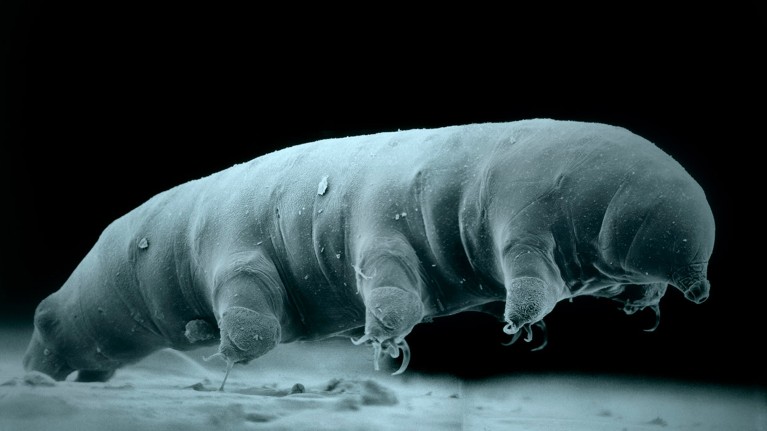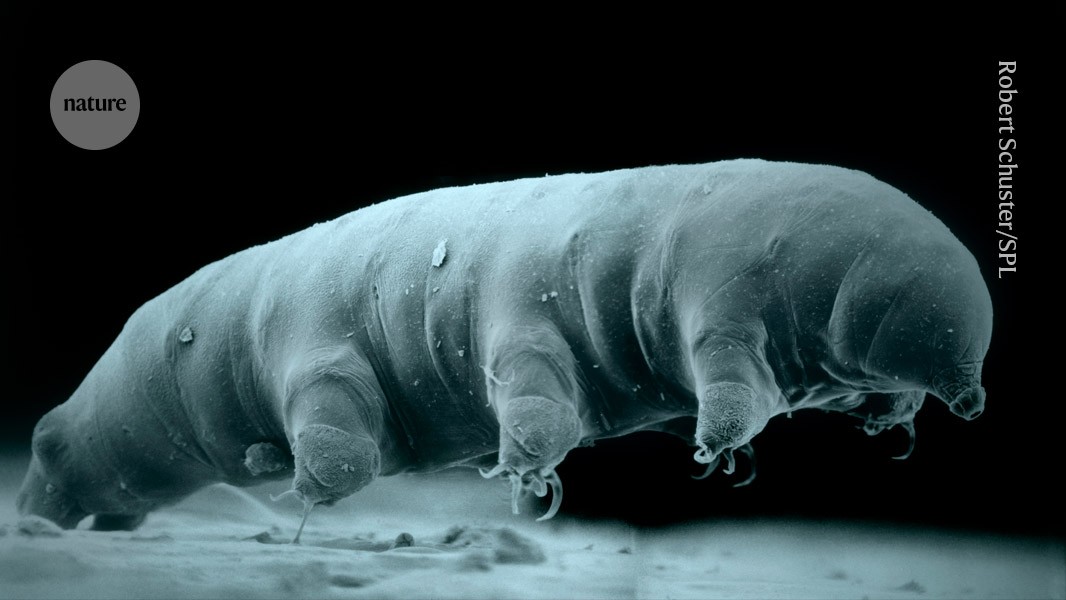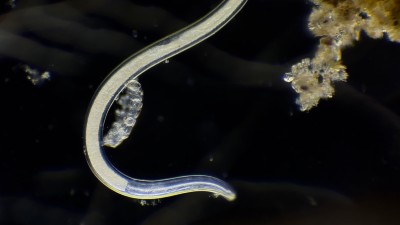
The new species is similar in appearance to this Hypsibius sp. tardigrade, photographed using an electron microscope.Credit: Robert Schuster/Science Photo Library
A newly described species of tardigrade is giving scientists insights into what makes these tiny eight-legged creatures so resistant to radiation.
Tardigrades, also known as water bears, have long fascinated scientists with their ability to withstand extreme conditions, including radiation at levels nearly 1,000 times higher than the lethal dose for humans. There are around 1,500 known tardigrade species, but only a handful are well-studied.
See a tardigrade ride a worm in the world’s weirdest rodeo — September’s best science images
Now, scientists have sequenced the genome of a species new to science, and revealed some of the molecular mechanisms that give tardigrades their extraordinary resilience. Their study, published in Science on 24 October1, identifies thousands of tardigrade genes that become more active when exposed to radiation. These processes point to a sophisticated defence system that involves protecting DNA from the damage that radiation causes and repairing any breaks that do occur.
The authors hope that their insights could be harnessed to help protect astronauts from radiation during space missions, clean up nuclear pollution or improve cancer treatment.
“This discovery may help improve the stress tolerance of human cells, benefiting patients undergoing radiation therapy,” says study co-author Lingqiang Zhang, a molecular and cellular biologist at the Beijing Institute of Lifeomics.
Protective genes
Around six years ago, Zhang and his colleagues ventured into Funiu Mountain in China’s Henan province to collect moss samples. Back in the laboratory and under the microscope, they identified a previously undocumented species of tardigrade, which they named Hypsibius henanensis. Genome sequencing revealed that the species had 14,701 genes, 30% of which are unique to tardigrades.
When the researchers exposed H. henanensis to radiation doses of 200 and 2,000 grays — far beyond what would be survivable for humans — they found that 2,801 genes involved in DNA repair, cell division and immune responses became active.
“It’s like when in wartime, when factories are refitted to just make munitions. It’s almost that level of retooling how gene expression is working,” says Bob Goldstein, a cell biologist at the University of North Carolina at Chapel Hill, who has been studying tardigrades for 25 years. “We’re fascinated by how an organism would change their gene expression to a point where they’re making that much transcript for specific genes.”
What Chernobyl’s stray dogs could teach us about radiation
One of the genes, called TRID1, encodes a protein that helps to repair double-strand breaks in DNA by recruiting specialized proteins at sites of damage. “This is a new [gene] that, to my knowledge, no one was studying,” says Goldstein.
The researchers also estimate that 0.5–3.1% of the tardigrade’s genes were acquired from other organisms through a process known as horizontal gene transfer. A gene called DODA1, which seems to have been acquired from bacteria, enables tardigrades to produce four types of antioxidant pigments called betalains. These pigments can mop up some of the harmful reactive chemicals that radiation causes to form inside cells, which account for 60–70% of radiation’s damaging effects.
The authors treated human cells with one of the tardigrade’s betalains and found that they were much better at surviving radiation than cells that were not treated.
No expiration date
Studying the molecular mechanisms that allow tardigrades to tolerate other harsh conditions, such as extreme temperatures, air deprivation, dehydration and starvation, could have wide applications. It could improve the shelf life of fragile substances such as vaccines, for example. “All your medicines have expiration dates — tardigrades don’t,” says Goldstein.
Comparing these mechanisms between different tardigrades is an important part of this research, adds Nadja Møbjerg, an animal physiologist at the University of Copenhagen. “We are still lacking knowledge of different tardigrade species out there,” she says.
These animals have “a font of protectants that will probably keep spilling out more that will be useful and interesting to understand”, says Goldstein. “We want to understand how those work and what potential they have.”




